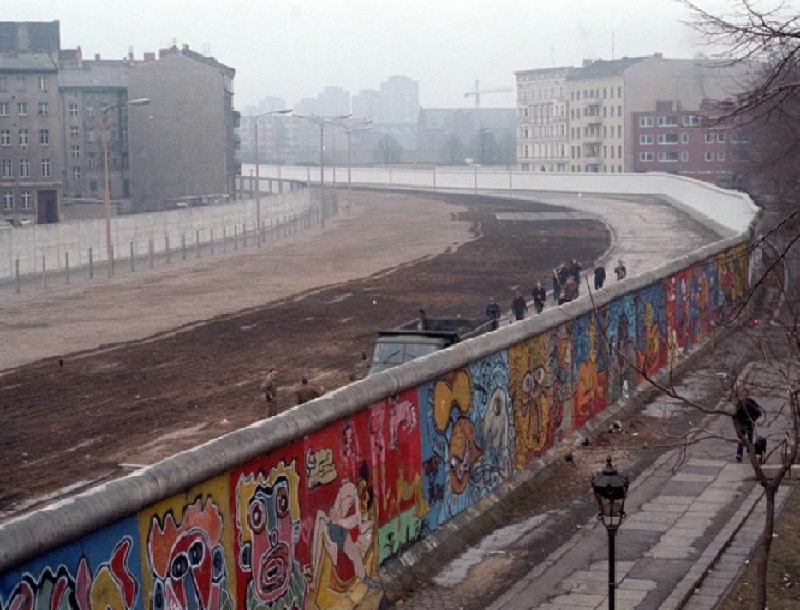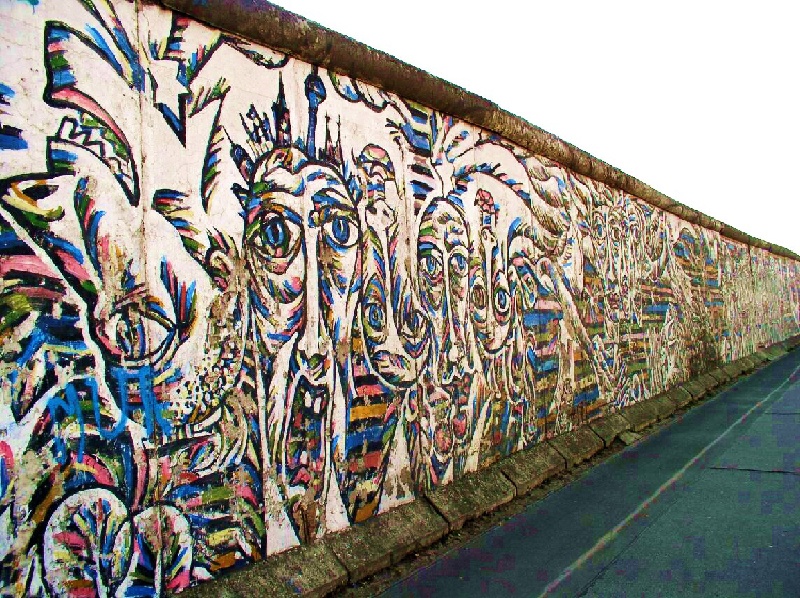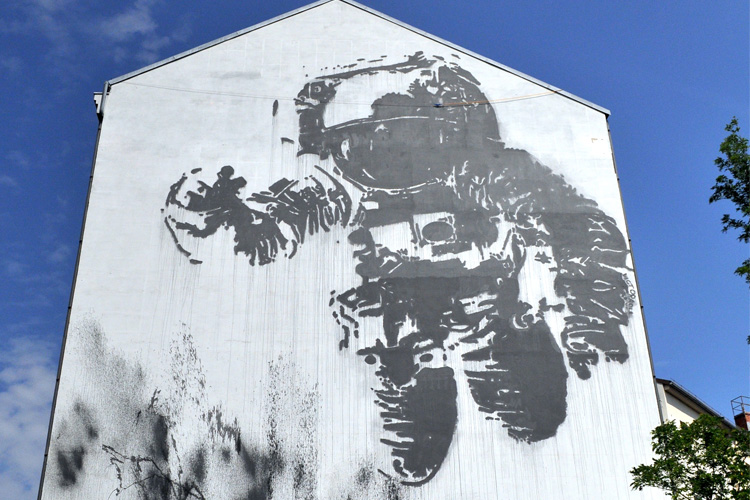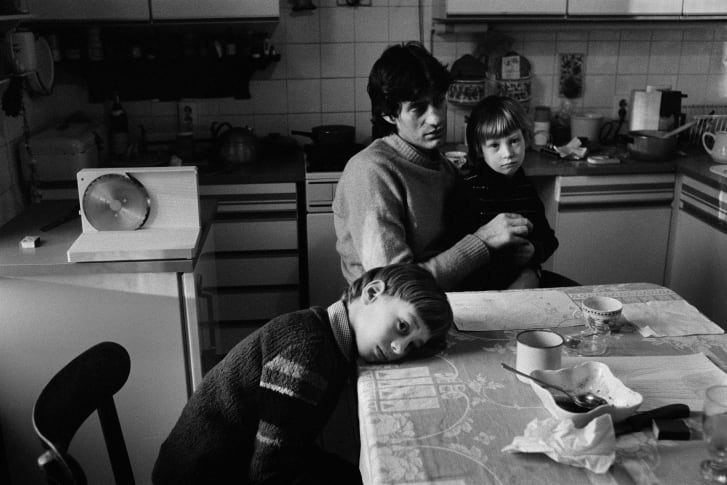3.4 How is art used to record history?
4 min read•june 18, 2024
Nathan Wichert
AP German 🇩🇪
29 resourcesSee Units
Was ist die Verbindung zwischen Kunst und Geschichte?
Malerei 🎨, Skulptur 🗿, Musik 🎧, Literatur 📚und andere Künste 🎭 werden oft als Aufbewahrungsort des kollektiven Gedächtnisses einer Gesellschaft angesehen. Kunst bewahrt, was faktenbasierte historische Aufzeichnungen nicht können: wie es sich anfühlte, zu einer bestimmten Zeit an einem bestimmten Ort zu existieren.
Painting, sculpture, music, literature, and other arts are often considered to be the repository of a society’s collective memory. Art preserves what fact-based historical records cannot: how it felt to exist in a particular place at a particular time.
Berlin Wall—Local Histories
Street art and graffiti originated as a way of expressing discontent and creating awareness of socio-political issues on a local, communal level, ultimately becoming an essential part of the global visual culture.
The art of stenciling, poster art, and wheat pasting, now some of the most common and popular street art techniques, developed from European revolutionary politics and were used by those in power to communicate political propaganda, as well as those who resisted, spreading the opposite ideas. In order to understand street art in a local context, you need to understand the socio-political setting in which it was created.
The Berlin Wall started as a barbed-wire fence and evolved into 14-foot-high concrete walls in the 1980s. These monstrous walls quickly became a canvas for those in West Berlin to express their opinions and show everyone else what they stood for.
The Wall quickly flourished on the West side, while the East side remained blank. In former East Germany, there was unfortunately no such thing as artistic expression. The Wall quickly became a marker of social and cultural differences between separate societies. This all changed in 1989 with the fall of the Berlin Wall. The city was officially reunited and became one again on October 3rd, 1990. At this point in time, the entire city of Berlin became a playground for artists coming from both sides and the street art scene thrived in the atmosphere of newly found freedom.
East Side Gallery—A Memorial to Freedom
Once the Wall collapsed and people were free to go from one side of the city to the other, the artists did just that. Artists from all over Berlin, Germany, and the world marched into the former East and began turning the fading, decrepit, gray buildings into amazing, vibrant art districts.

Image taken from berlinstreetart.com.
During this time artists embarked on one of the most significant mural projects ever attempted. Artists began taking remains of the Wall and painting them. In 1990, artists from all over the world were invited to paint on the Wall’s empty east side to celebrate the reunification and express hopes for a brighter future.

Image taken from berlinstreetart.com.
The remains of the Wall, with over one hundred murals, became known as the East Side Gallery, one of the largest open-air galleries in the world. People from all over the world visit the East Side Gallery each year. In 2018, over 1 million people visited! (local.de).

Image taken from berlinstreetart.com.
Photography in East and West Germany
Art from the former Deutsche Demokratische Republik (German Democratic Republic), or East Germany, has received limited exposure over the years due in large part to the strict limitations imposed by the former authoritarian state.
Art curator Sonia Voss displayed a new collection of photographs from former DDR at a 2019 photography festival in France. The images span the last decade before the Wall fell and focus on teenagers. The subjects of the photographs and the photographers themselves were not around when the DDR was first established.
"These were young people who were very detached from political ideas, but somehow just as tired and furious about the constraints that they were living with, which made them more likely to break the norms or push the limits compared to previous generations."

Image taken from cnn.com.
The image above offers viewers a look behind the government-created façade of optimism. This was real and it was not to be seen by anyone else.
In einem Sinn ist Kunst eine Art von Kommunikation; Es ermöglicht Menschen aus verschiedenen Kulturen und zu verschiedenen Zeiten, über Bilder, Töne und Geschichten miteinander zu kommunizieren. Kunst ist oft ein Vehikel für sozialen Wandel. Es kann den politisch oder sozial Entrechteten eine Stimme geben. Ein Lied, ein Film oder ein Roman kann bei denen, die ihm begegnen, Emotionen hervorrufen und sie dazu inspirieren, sich für Veränderungen einzusetzen.
Art, in a sense, is communication; it allows people from different cultures and different times to communicate with each other via images, sounds, and stories. Art is often a vehicle for social change. It can give voice to the politically or socially disenfranchised. A song, film, or novel can rouse emotions in those who encounter it, inspiring them to rally for change.
Strive for Five Vocab 🔑🔑
| das Kunstwerk | work of art |
| die Ausstellung | exhibition |
| der Hintergrund | background |
| der Vordergrund | foreground |
| die Landschaft | landscape |
| darstellen (stellt....dar) | represent |
| der Stil | style |
| ausstellen | to display, exhibit |
| der Künstler | artist |
| das Graffiti | graffiti |
| spritzlackieren | to spray paint |
| die Farbsprühdose | spray paint can |
| das Atelier | studio |
| die Inspiration | inspiration |
| beliebt | popular |
| berühmt | famous |
| realistisch | realistic |
| die Fantasie | imagination |
| die Kunst | art |
| die Art | kind, type |
| das Gebäude | building |
| das Monument | monument |
| die Wand | wall (in a house) |
| die Mauer | wall (Berlin Wall) |
Other questions to consider 🤔 for Einflüsse von Schönheit und Kunst
- How does art 🎨 influence the quality of life and values in a community?
- What is the role/importance of art 🎭 in German-speaking 🇩🇪 🇨🇭 🇦🇹 communities?
- How do the arts 🖌️ capture and reflect the history 📜 of a community?
- How is the concept of ✨ beauty 💫 defined within a culture?
- How does 🎨 art 🎭 challenge and reflect cultural perspectives?
Browse Study Guides By Unit
👨👩👧Unit 1 – Families in Germany
🗣Unit 2 – Language & Culture in Germany
🎨Unit 3 – Beauty & Art in Germany
🔬Unit 4 – Science & Technology in Germany
🏠Unit 5 – Quality of Life in Germany
🌪Unit 6 – Challenges in Germany
📚Study Tools
🧐Exam Skills

Fiveable
Resources
© 2025 Fiveable Inc. All rights reserved.